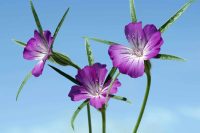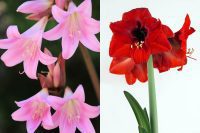Spring and summer are traditionally the seasons we expect to see a vibrant collection of flowering plants in the garden, but there are some plants that flower in winter, providing some much-needed colour in the house or the garden.
Climate plays a role, for example, it is mid-winter here in Sydney, but it is not uncommon for geraniums to flower year-round, and I currently have delphinium and cosmos in bloom. Colder climates will have fewer flowering plants, but there are still a number of plants that can be enjoyed, even in cool climates.
Cyclamen
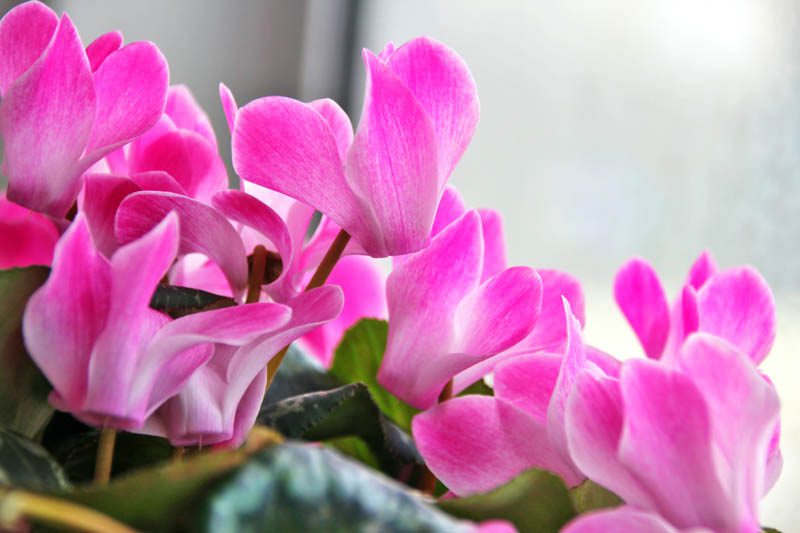
- Family: Primulaceae
- Botanical name: Cyclamen persicum
- Plant type: Perennial
- Common names: Sowbread, Florist’s cyclamen, Ivy-leaved cyclamen, Persian violet
- Mature size: 15 cm (6 inches)
- Sun exposure: Partial
- Hardiness: -10°C
- Soil type: Acidic
- Propagation: Sowing
- Flower colour: White, pink, red, pink and white
About:
Cyclamen is a genus of 23 species of flowering tuberous perennials native to the alpine woodlands of Europe and the Mediterranean. Heart-shaped flowers grow in late winter and early spring, making them a popular indoor and outdoor bedding plant and you will see a large range of cyclamens for sale in supermarkets and garden centres during the colder months.
Place cyclamen in a pretty ceramic pot on the dining table for a splash of winter colour.
Care:
Cyclamens like to grow in full or part shade, in well-draining soil. Only water when the top inch of soil had dried out as cyclamens can be easily over-watered. For those of you growing cyclamen indoors, once the plant has finished flowering, it can be transplanted outside.
Hellebore

- Family: Ranunculaceae
- Botanical name: Helleborus spp.
- Plant type: Herbaceous perennial
- Common names: Christmas rose
- Mature size: 20 – 30 cm (8 – 12 inches)
- Sun exposure: Dappled shade
- Hardiness: – 18°C
- Soil type: Neutral, alkaline
- Propagation: Sowing, cutting, division
- Flower colour: Black, white, pink, purple, white and pink, yellow, green, apricot
About:
Hellebore is a genus of 15 flowering evergreen perennials native to southern and western Europe. These showy, winter-blooming plants are commonly planted in cottage gardens. Christmas rose (H. niger) and Lenten rose (H. orientalis) are the most commonly cultivated hellebores. Bloom time occurs from winter to spring.
The name hellebore relates to its toxicity, elein means to injure, and bora means food in Greek. Toxic properties include bufadienolides, glycosides, veratrin and prtoanemonin.
Care:
The preferred location for hellebores is dappled light. Plant under deciduous trees, so they receive sunlight in winter, but shade in summer.
Hellebore requires slightly moist, alkaline soil and should be watered when the top layer of the soil starts drying out. Fertilise every 2-3 months during the growing season.
Camellia
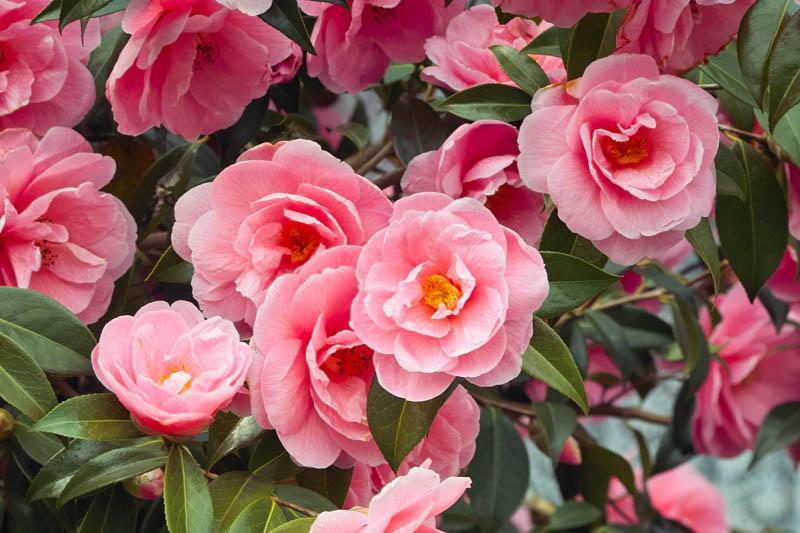
- Family: Theaceae
- Botanical name: Camellia japonica
- Plant type: Shrub, evergreen
- Common names: Camellia, Common camellia,
- Mature size: 1.5 metres (5 feet)
- Sun exposure: Dappled or full shade
- Hardiness: – 20°C
- Soil type: Loamy, clay, sandy
- Propagation: Sowing, grafting, cutting, layering
- Flower colour: White, pink, red, salmon, yellow, cream
About:
Camellia is a genus of flowering evergreens native to mainland China, Taiwan, southern Korea and southwestern Japan. The plant produces stunning rose-shaped flowers in winter and early spring.
Care:
Camellias is an easy-to-care-for plant and is resistant to almost all pests and diseases. Its preferred location is partial shade, protected from strong winter winds. Soil should be well-drained, and slightly acidic. Water when the soil feels significantly dry and fertilise every 2-3 months during the growing season.
Snowdrops
- Family: Amaryllidaceae
- Botanical name: Galanthus nivalis
- Plant type: Perennial bulb
- Common names: Snowdrop, Common snowdrop, Fair maids of February, Little sister of the snows, Purification flower, Candlemas bells, Candlemas lily, Common bells
- Mature size: 10 cm (4 inches)
- Sun exposure: Part-shade
- Hardiness: – 20°C
- Soil type: Loamy, clay, sandy
- Propagation: Division or seed
- Flower colour: White
About:
Snowdrops are a flowering bulb native to Europe and the middle east. The arrival of snowdrops in the garden signals the impending end of winter.
Snowdrops are members of the Amaryllis family, with includes hippeastrum and daffodils. G.nivalis has a single drooping, bell-shaped flower with six petal-like sepals, which have a distinctive green marking at the petal tip. The name Galanthus comes from the Greek word gala (milk), anthos (flower) and the Latin word nivalis, which means snow-covered.
Care:
Plant in clusters of 20 – 30 bulbs a few cm apart. Over time, snowdrops will naturalise rapidly, forming a beautiful carpet of white flowers. Their preferred location is part shade, under deciduous trees, but they will tolerate full sun.
Jonquils
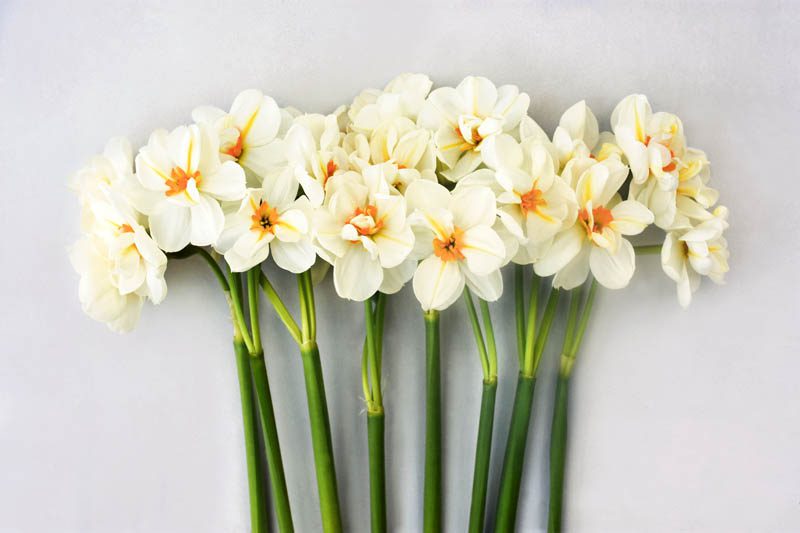
- Family: Amaryllidaceae
- Botanical name: Narcissus jonquilla
- Plant type: Perennial bulb
- Common names: Jonquil, Paper white
- Mature size: 30 cm (12 inches)
- Sun exposure: Part-shade
- Hardiness: -10°C
- Soil type: Rich, well-drained but moist
- Propagation: Division
- Flower colour: Cream, yellow
About:
Jonquils are a bright, flowering plant in the daffodil family that produces sweet-smelling blooms in late winter to early spring. It is native to the Mediterranean region. The strongly scented oil has been used for centuries in the perfume industry.
Care:
Plant jonquils in large clusters in garden beds or in pots. Their preferred location is full sun in moist but well-drained soil. Once the jonquil has finished flowering, allow the leaves to die back naturally to allow the bulb adequate food storage for next year’s blooms. Fertilise every 2 – 3 months during the growing season.
Winter jasmine
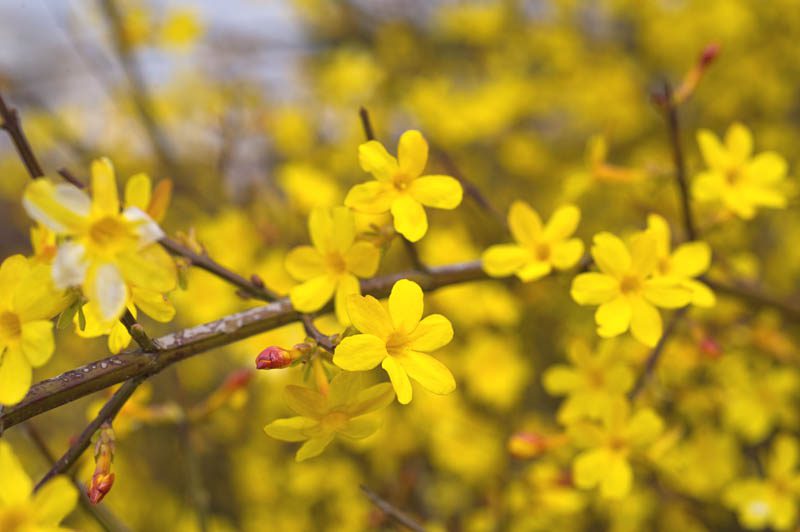
- Family: Oleaceae
- Botanical name: Jasminum nudiflorum
- Plant type: Deciduous shrub
- Common names: Winter jasmine, Winter-flowered jasmine, Winter-flowering jasmine
- Mature size: 3 metres (10 feet)
- Sun exposure: Full to partial sun
- Hardiness: – 18°C
- Soil type: Chalk, loam, sand, clay
- Propagation: Layering semi-hardwood cuttings
- Flower colour: Yellow
About:
Winter jasmine is a slender, deciduous shrub native to China that is prized for its wispy branches and mass of bright yellow flowers that stand out in late winter to early spring. As the branches touch the ground, they produce roots. Unlike other jasmine plants, winter jasmine has no scent.
In China, winter jasmine is known as Yingchun, which means ‘flower that welcomes spring’.
In its native China, winter jasmine is often called ‘Yingchun’ (迎春), which means ‘the flower that welcomes spring’.
Care:
Winter jasmine can be grown as a shrub or vine depending on the conditions. It likes to grow in full sun to part shade in sandy loams with regular water. The leaves die back in autumn, and flowers are produced on bare stems.
Winter daphne
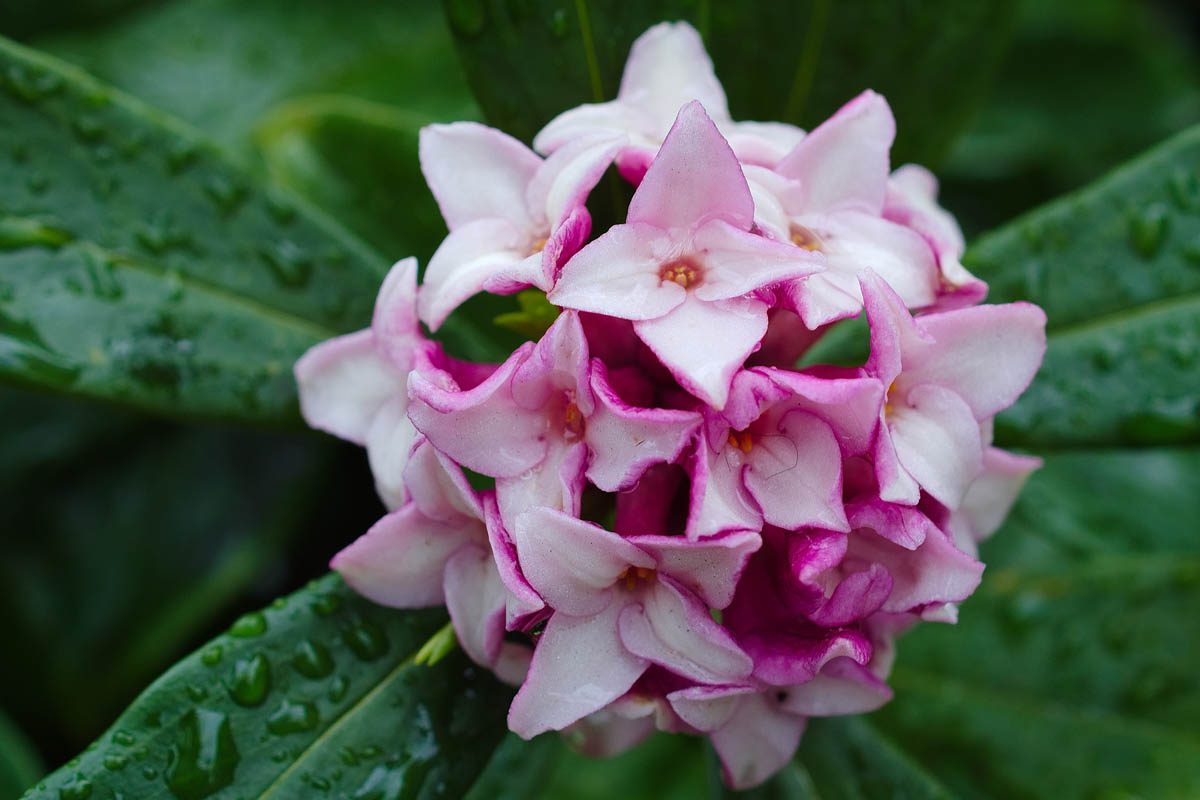
- Family: Thymelaeaceae
- Botanical name: Daphne odora
- Plant type: Broadleaf evergreen shrub
- Common names: Daphne
- Mature size: 90 – 120 cm (36 to 48 inches)
- Sun exposure: Full to partial sun
- Hardiness: – 18°C
- Soil type: Chalky, loam, clay, sand; well-drained
- Propagation: Semi-hardwood cuttings
- Flower colour: Pink and white
About:
Winter daphne is a broadleaf evergreen shrub native to China. The highly scented, showy, rounded flowers grow in clusters from late winter to early spring, followed by small red berries known as drupes. Winter daphne is perfect for small yards,
Daphne odora ‘Aureomarginata’ is a popular cultivar with variegated leaves.
Care:
Daphne has a reputation for being a difficult plant to grow, but this isn’t so. Most winter flowering shrubs become available in the spring months and it can take several years for winter daphne to reach full maturity. Choose a sunny to partial shade location, but ensure the plant is in a sheltered position, with chalky or loam soil that is slightly alkaline.
Winter honeysuckle

- Family: Caprifoliaceae
- Botanical name: Lonicera fragrantissima
- Plant type: Perennial flowering vine
- Common names: Winter honeysuckle
- Mature size: 1.8 – 3 metres (6 – 10 feet)
- Sun exposure: Full sun to part shade
- Hardiness: – 20°C
- Soil type: Chalky, loam, well-drained
- Propagation: Division, cutting, layering
- Flower colour: Off white
About:
Winter honeysuckle is a large bush that produces highly scented flowers creamy white flowers in the winter and spring. In cooler climates winter honeysuckle is deciduous but remains evergreen in warmer climates. It is widely cultivated for its sweet-smelling flowers but can become somewhat of a tangled mess of spreading branches. Unfortunately, it can also escape cultivation and become invasive in a wild habitat.
Care:
Winter honeysuckle can grow in full to part shade. It prefers well-drained, chalky, loam soil, and should be watered when the top 3 cm has dried out. Keep the vine in check by regular pruning.
Snow crocus
- Family: Iridaceae
- Botanical name: Crocus chrysanthus
- Plant type: Perennial bulb
- Common names: Crocus, Snow crocus, Golden crocus
- Mature size: 15 cm (6 inches)
- Sun exposure: Full sun
- Hardiness: – 20°C
- Soil type: Well drained, neutral pH
- Propagation: Division
- Flower colour: White, purple, yellow, variegated
About:
Snow crocus is one of the earliest varieties of crocus to bloom, often poking its bright colourful flowers through the snow. Native to Greece, Turkey and Bulgaria, the calyx-shaped flowers emerge before the fine foliage, and open in response to light.
Care:
A chilling period of 6 weeks before planting is necessary for mild winter climates to induce flowering. In cooler areas, winter crocus does not require a chilling period and can be planted directly into the ground where it will become naturalised. Crocus can be grown in lawns (in cooler climates), garden beds or pots. Their preferred location is full sun but can tolerate dappled shade. Water when the top 3 cm of soil has dried out and fertilise once in spring.
Saucer magnolia
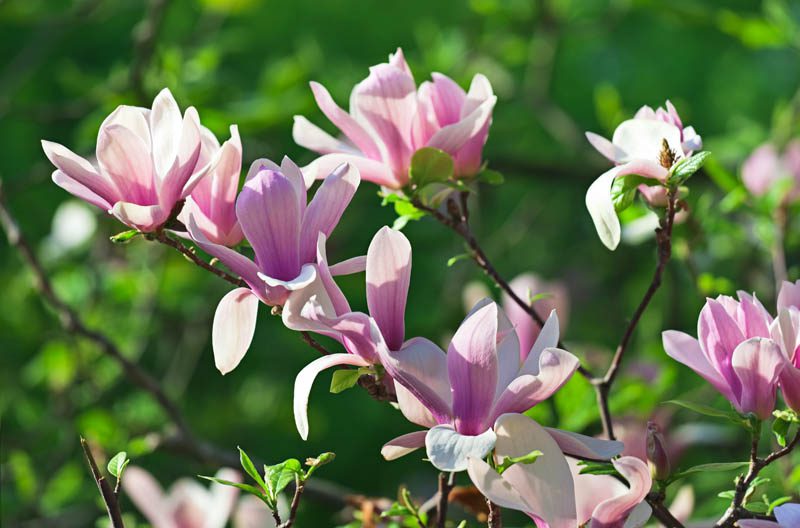
- Family: Magnoliaceae
- Botanical name: Magnolia x soulangiana
- Plant type: Tree, shrub
- Common names: Magnolia, Saucer magnolia, Tulip magnolia
- Mature size: 4 – 5 metres (13 – 16 feet)
- Sun exposure: Full to partial sun
- Hardiness: – 29°C
- Soil type: Moist, but well-drained, neutral to acidic
- Propagation: Sowing, grafting, cutting, layering, tissue culture
- Flower colour: Pink to burgundy
About:
Saucer magnolia is a hybrid of Magnolia heptapeta and Magnolia liliiflora, which are both native to Japan. Its large, cup-like flowers bloom on bare branches from late winter into spring, providing a stark contrast to the winter landscape. These flowers provide a vital pollen source for early-rising insects. The scented flowers range in colour from pale pink to deep burgundy.
Care:
Saucer magnolia is an easy-to-care-for plant with resistance to most pets and diseases. It can grow in full sun and should receive at least 6 hours of sunlight a day. Saucer magnolias grow in slightly acidic, moist but well-drained soil.
Water deeply and frequently during the first year to help establish the roots, once established, saucer magnolias have some tolerance for dry conditions.
Flaming katy
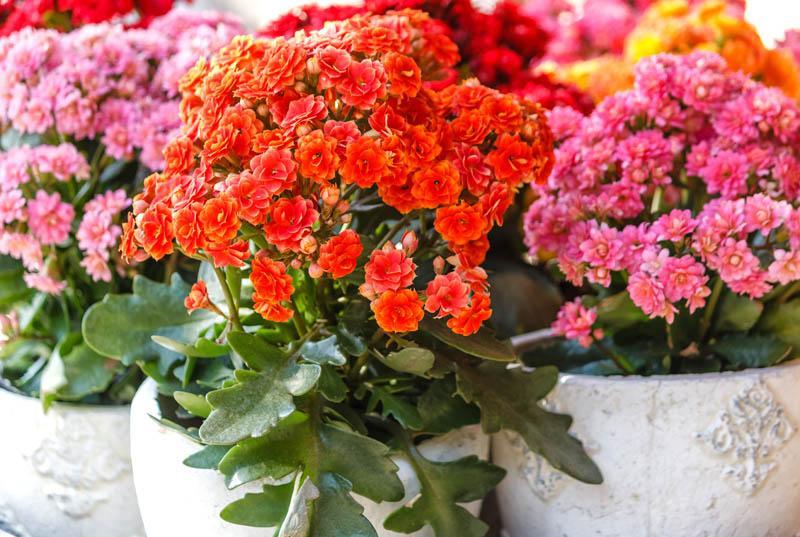
- Family: Crassulaceae
- Botanical name: Kalanchoe blossfeldiana
- Plant type: Succulent, perennial
- Common names: Florist kalanchoe, Christmas kalanchoe, Madagascar widow’s-thrill
- Mature size: 10 – 50 cm (4 – 19 inches)
- Sun exposure: Full sun
- Hardiness: – 1°C
- Soil type: Sandy, well-drained
- Propagation: Cutting
- Flower colour: Yellow, red, purple, orange, pink
About:
Flaming katy is a succulent originating from Madagascar. This popular houseplant is grown for its brightly coloured flowers bloom in winter. Flaming katy is slow-growing and can take 3 – 5 years to reach full maturity.
Care:
Flaming katy is an easy-to-care-for plant, as a succulent, it needs to grow in full sun, and well draining soil.
Julia is a writer and landscape consultant from Wollongong with a love of horticulture. She had been an avid gardener for over 30 years, collects rare variegated plants and is a home orchardist. Julia is passionate about learning and sharing her knowledge of plant propagation and plant toxicology. Whether it’s giving advice on landscape projects or sharing tips on growing, Julia enjoys helping people make their gardens flourish.



